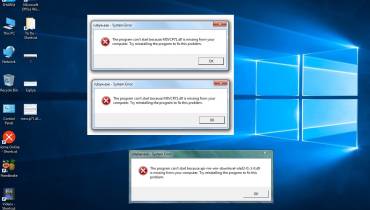8 Risk Assessment Blind Spots (& How to Overcome Them)

It’s all too easy to be blindsided in business—it can happen in an instant.
Even a brief lack of basic awareness can be consequential, and a lack of visibility when assessing risks (called risk assessment blind spots) causes major problems in business.
That’s why you need to assess blind spots and have a full view of your business at all times.
What Are Risk Assessment Blind Spots?
Think of the blind spot on the side of your car. If you don’t have your side mirrors positioned correctly, you might miss the presence of a car driving right next to you. The result could be a crash if you decide to change lanes without properly checking your blind spot first.
A risk assessment blind spot is any area in your business that doesn’t have adequate oversight due to visibility limitations, such as not having access to real-time data, dashboards with alerts, or analytical reports.
The potential result of limited visibility when running a business could spell disaster. That is, unless you proactively gain visibility that diminishes your blind spots and prevents business risks.
So, what are some common risk assessment blind spots in business you should be aware of and strive to remove?
Common Risk Assessment Blind Spots
Some common risk assessment blind spots that you may not even be aware of to check include:
1. Believing You’re Prepared for Everything
Chances are, you already have a risk assessment checklist that is followed to a T. Believe it or not, such a list is not all-encompassing and cannot adequately cover anything that may come up at any time. Use the list, but regularly evaluate whether it's adequate. Take away expired risks and add new ones as they arise.
2. Failing to Assess the Risks of Your Suppliers, Vendors, and Other Key Players
Looking at only your own direct risks is not even close to being enough. There are countless risks that inevitably trickle down to you, originating from seemingly far-removed locales. Continually ensuring the quality and diversity of your worldwide partners is key to diminishing disruptions.
3. Blaming Individuals Instead of Processes
Oftentimes, a single scapegoat is used to save face. This isn’t a fair practice, nor is it productive. Not only does it discourage people from coming forward with informative critiques, but it doesn’t fix the problem or prevent it from occurring again.
Additionally, the likelihood that the error originated from a single decision is low. Take a hard look at all the systems and processes surrounding the issue and make changes as necessary.
4. Shutting Down Debate
It’s unwise to quiet differing opinions and objections. There are always multiple sides to be heard, all of which offer valuable input that can lead to the best decision overall.
However, there should be some guidelines to make such conversations and debates effective:
- Avoid redundant representatives.
- Engage those who are not speaking up (but should).
- Prioritize the subject focus.
- Use all available data without structuring it to fit a particular narrative.
- Incorporate extreme scenarios and their consequences.
5. Forgetting to Visualize the Future
Similar to believing you’ve prepared for everything, forgetting that the world changes can get you stuck. Unfortunately, success in the past says nothing about your ability to have a successful future. What are the possibilities far down the road in terms of supply availability, demand for certain products, time-saving technology, and growing customer expectations?
It may seem pointless to make predictions, but time moves on and you’ll certainly someday find yourself somewhere new. It’s best to work toward the future and be ready to roll, rather than to be left behind in the dust.
6. Settling for Near-Compliance
There are times in life when “good enough” is just that. When it comes to risk management, however, being satisfied with a normalization of deviance puts your company at risk. Resolve all non-compliant and near-compliant risks immediately. Enforce standards, regulations, rules, laws, policies, and practices through audits, certifications, and even culture.
7. Compromising on the Quality of Your Decisions
There are many ways this is done unintentionally. Decisions are compromised when you:
- Conveniently ignore facts.
- Rely on “experts” and dominant personalities to guide the dialogue.
- Don’t seek out hidden possible outcomes.
- Draw false conclusions due to logical fallacies.
- Manage toward a singular view of the future.
Work to remove decision biases to gain more accurate insight that leads to making higher quality decisions.
8. Not Acknowledging that Conflict Is Inevitable
Expect tension when evaluating risks and assigning weight to them. Why? Because it helps maintain an appropriate balance, creates protection, and adds value.
Maintain an independent risk management role, but encourage direct reporting lines and conduct regular, mandatory overview sessions so that appropriate considerations can be made.
Overcoming Risk Assessment Blind Spots: Top Tips
Taken from the eight risks listed above, here is a summary of what you can do to overcome risk assessment blind spots:
- Regularly evaluate whether your risk assessment checklist is adequate.
- Continually ensure the quality and diversity of your worldwide partners.
- Look at all the systems and processes surrounding any issue that arises, and make changes as necessary.
- Use common-sense guidelines to make conversations effective.
- Plan possibilities and expectations of the distant future, then work toward them.
- Immediately resolve all non-compliant and near-compliant risks by enforcing standards, regulations, rules, laws, policies, and practices.
- Remove decision biases to gain more accurate insight.
- Maintain an independent risk management role, but encourage direct reporting lines and conduct regular, mandatory review sessions.
Implementing these practices will have significant domino effects, including a better, 360-degree view that’ll alleviate risky actions and their resulting negative consequences.


























